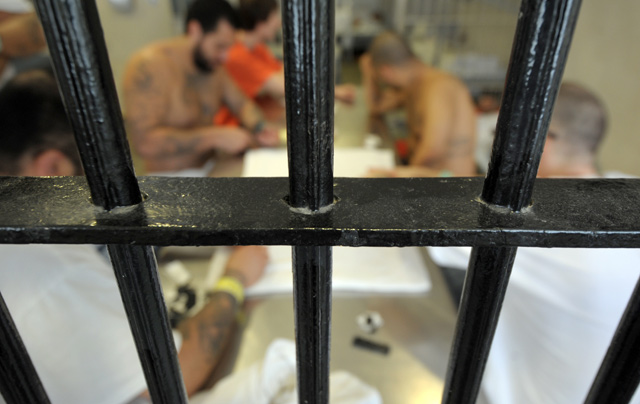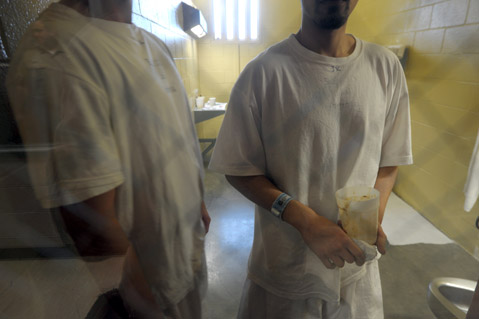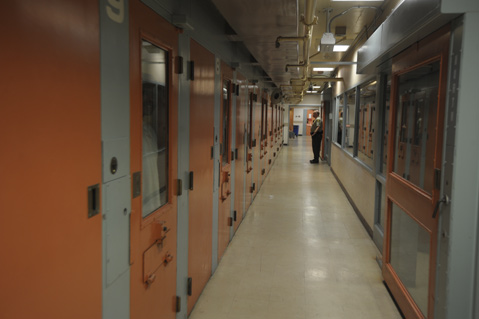
Last April marked the first time an outside group inspected the County Jail since 2007. The highly anticipated — and largely damning — findings made public this week criticize the amount of time inmates are placed in small, windowless “safety cells,” or “rubber rooms,” as they’re known.
“The county is a real outlier in California and nationally with this practice,” said Melinda Bird, an attorney with Disability Rights California, the state-mandated advocacy group seeking to protect the rights of inmates with mental-health disabilities. Most jails do not hold inmates in a safety cell for more than a few hours, Bird said; Disability Rights found inmates with mental illness and behavior problems were housed in safety cells for “three days at a time on a repeated basis” and that custody staff confirmed placement was “not temporary.”
Other problems that the 26-page report stressed include out-of-cell time, access to mental-health medications, a high percentage of pretrial detainees, delays in responding to requests, and inmates sleeping on the floor, among others. It concluded there is “probable cause” that “prisoners with disabilities are subject to neglect.” Sheriff Bill Brown, whom the group called “forward-looking,” flatly disagreed. “We recognize there are areas for improvement,” he said in an email, “but to say that inmates are being neglected or abused is an unfair, unjust, and inflammatory statement.”
As for safety cell protocols, Brown said he is reviewing policy to decrease the time inside and provide more contact with mental-health professionals. He noted, however, they are in compliance with state law. (Brown added Crisis and Recovery Emergency Services is called in within 72 hours for mentally-ill inmates.) Regardless of state laws, Bird argued, her first priority is upholding civil rights.
Populations of county jails surged after realignment — state prisoners were relocated to county jails — was enacted in 2011, causing widespread overcrowding. That, coupled with the fact that the Santa Barbara County Jail has been haphazardly remodeled three times since it was built in 1971, makes for an infrastructure and operational nightmare. Brown often invokes the structural problem to argue for the new 376-bed northern branch jail project, slated to be up and running by 2018.

In the past three years, Disability Rights won legal battles against Fresno and Los Angeles counties for dangerous conditions in their jails, Bird said. Asked if she anticipated filing legal action against Santa Barbara County, she said, “I dearly hope not.” In March, the group will conduct more on-site visits as part of an “intensive targeted investigation.”
The grim report goes beyond blaming the building woes and faults people. During the April inspection, Bird said, a custody deputy did not even open the small Plexiglas window when he checked on an inmate who had been placed in a safety cell the night before. The report states the officer stepped up to the clipboard, made a notation on the log hanging on the door, and walked away. “It reflected disgrace,” Bird said. “To me it suggested that this was pretty common.” (The log had “terse” notes on it such as “breathing” and “awake.”)
Brown said in a written rebuttal that mental-health staff evaluates prisoners in safety cells twice each day. (Disability Rights said that practice was not confirmed in the records they reviewed.) Brown added custody staff is made up of “caring, dedicated, hard-working professionals who provide a vital public safety service.” He added, “While we are proud of the work being done at the jail, we always seek to improve.”

Disability Rights also had a poor review for Corizon Health Inc., the correctional health-care firm scrutinized last fall by county supervisors and mental-health advocates, namely Families ACT! One inmate interviewed, the report found, had been placed in a safety cell four or five times in the past month. During that time, he did not see a mental-health provider or receive a response to his medication request.
Patients on a psychiatric hold — also known as 5150 holds — were left in the cells for the entire 72-hour duration of the hold without access to mental-health treatment, the report states; attorneys reported this happens frequently.
California Disabilities recommended protocol that identifies all prisoners who are on mental-health medication or otherwise require treatment during initial booking. Under current policy, Brown said, inmates are seen by mental health or medical personnel if they answer “yes” to medical or mental health questions during intake. An additional nurse was recently hired to assist with medical screenings, Brown added.
Another problem identified was lack of out-of-cell time. Even though prisoners are offered three hours of recreation time per week and a few-minute shower every other day — in compliance with state law — that still amounts to solitary confinement for inmates.
“In the past,” Bird said, “you’d talk to people in jail, and they’d say ‘I can’t wait to get to prison.’ Why is that? It’s because there had been two lawsuits against the state prison system. We haven’t done that parallel work in county jails.”



